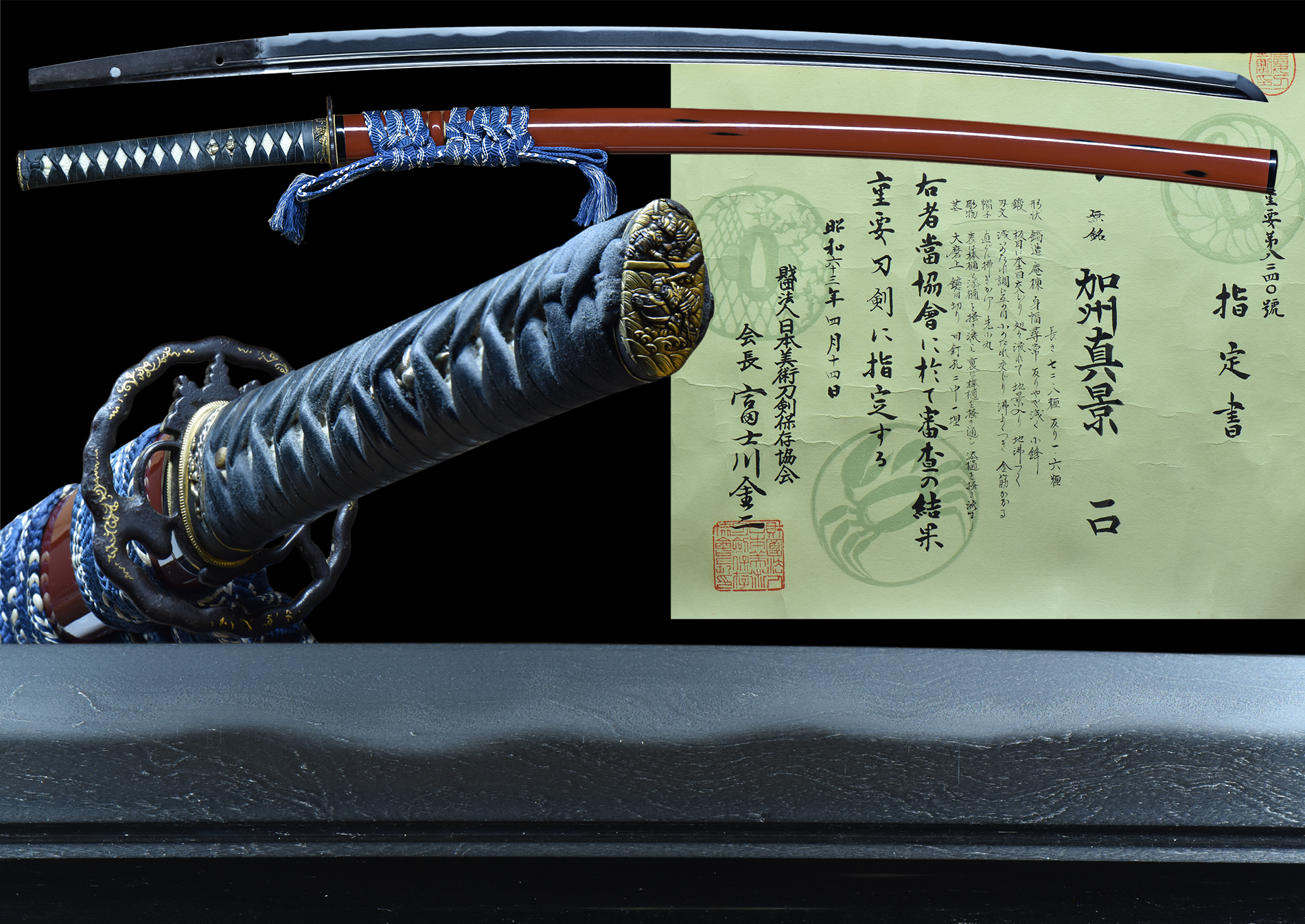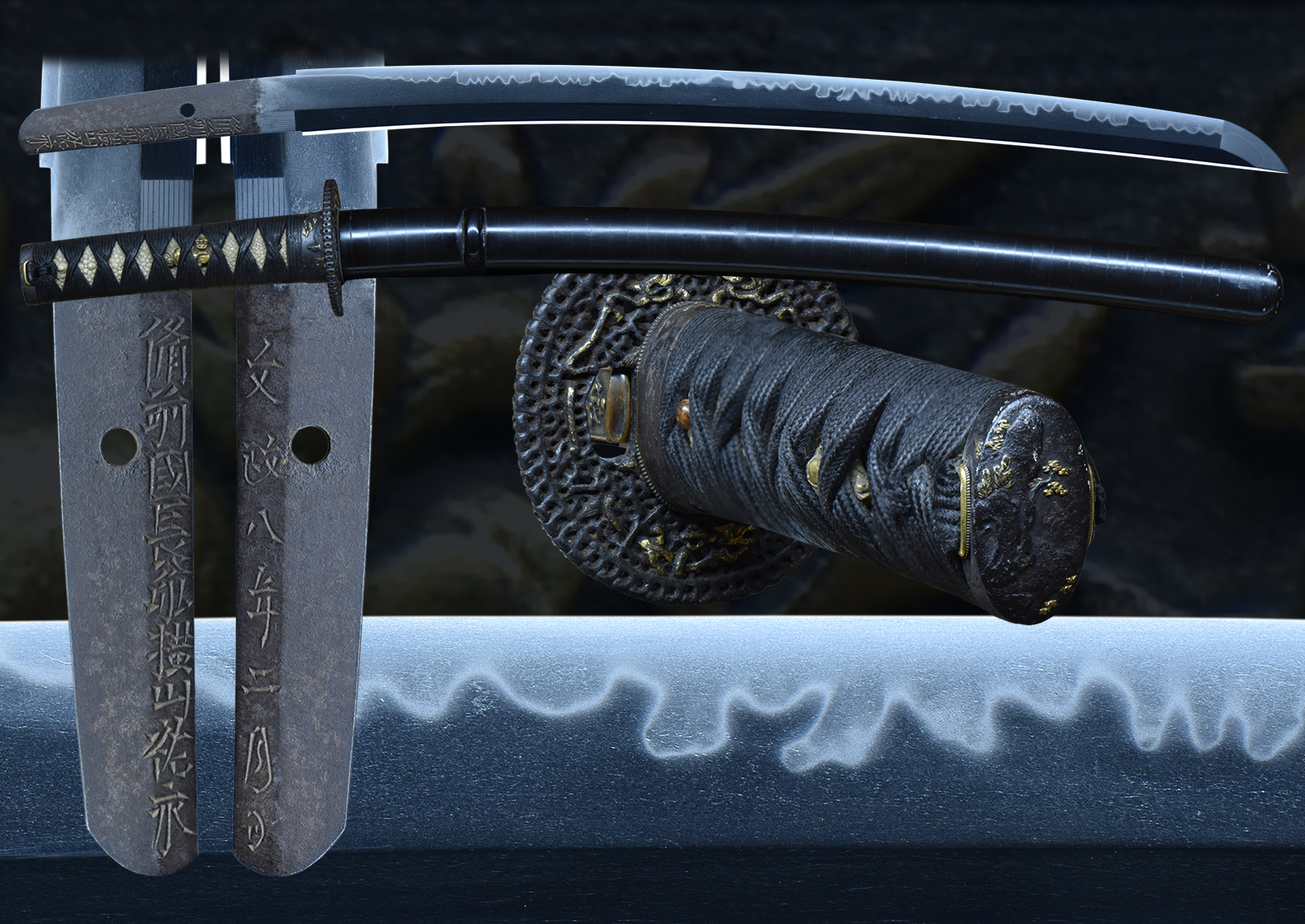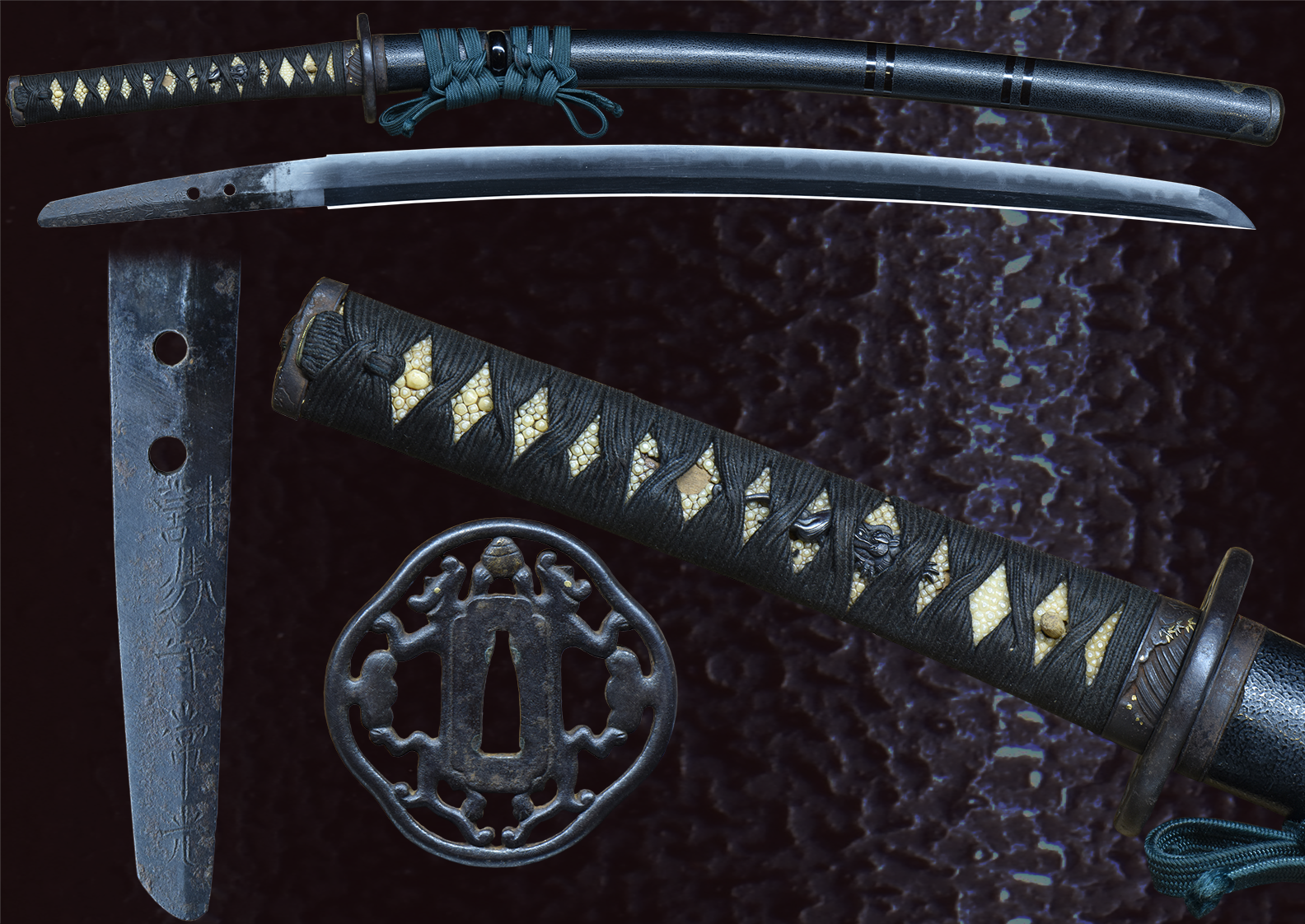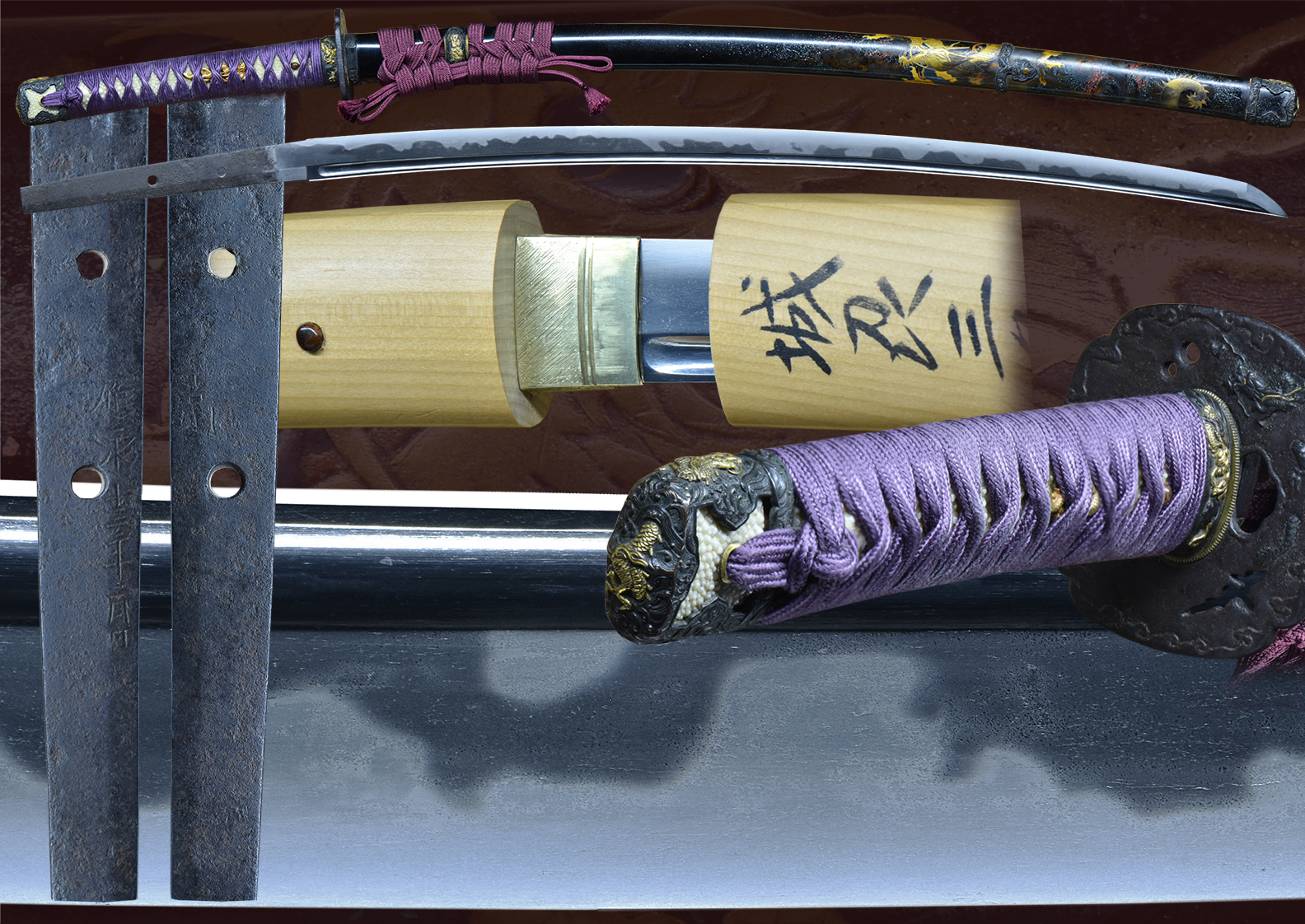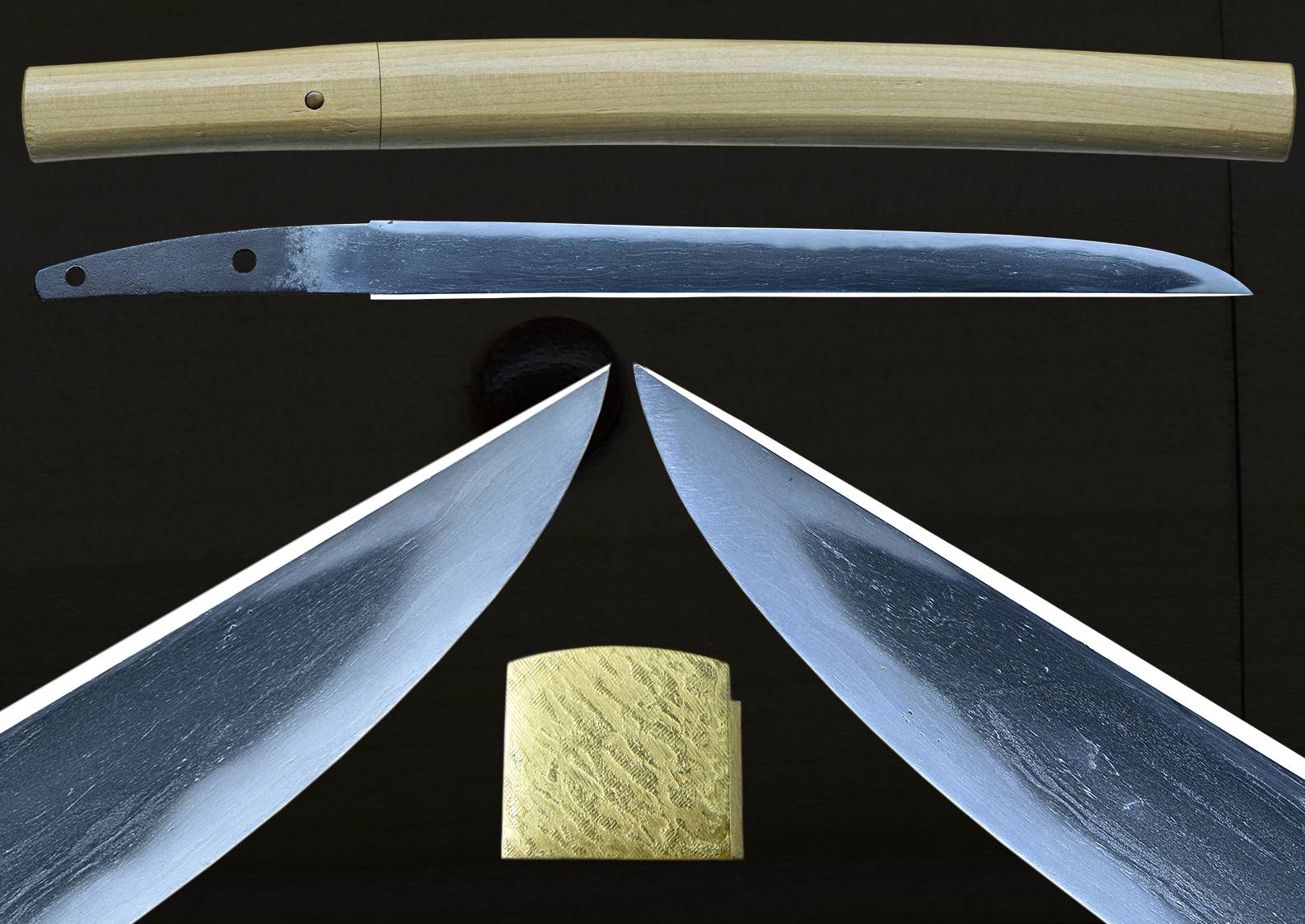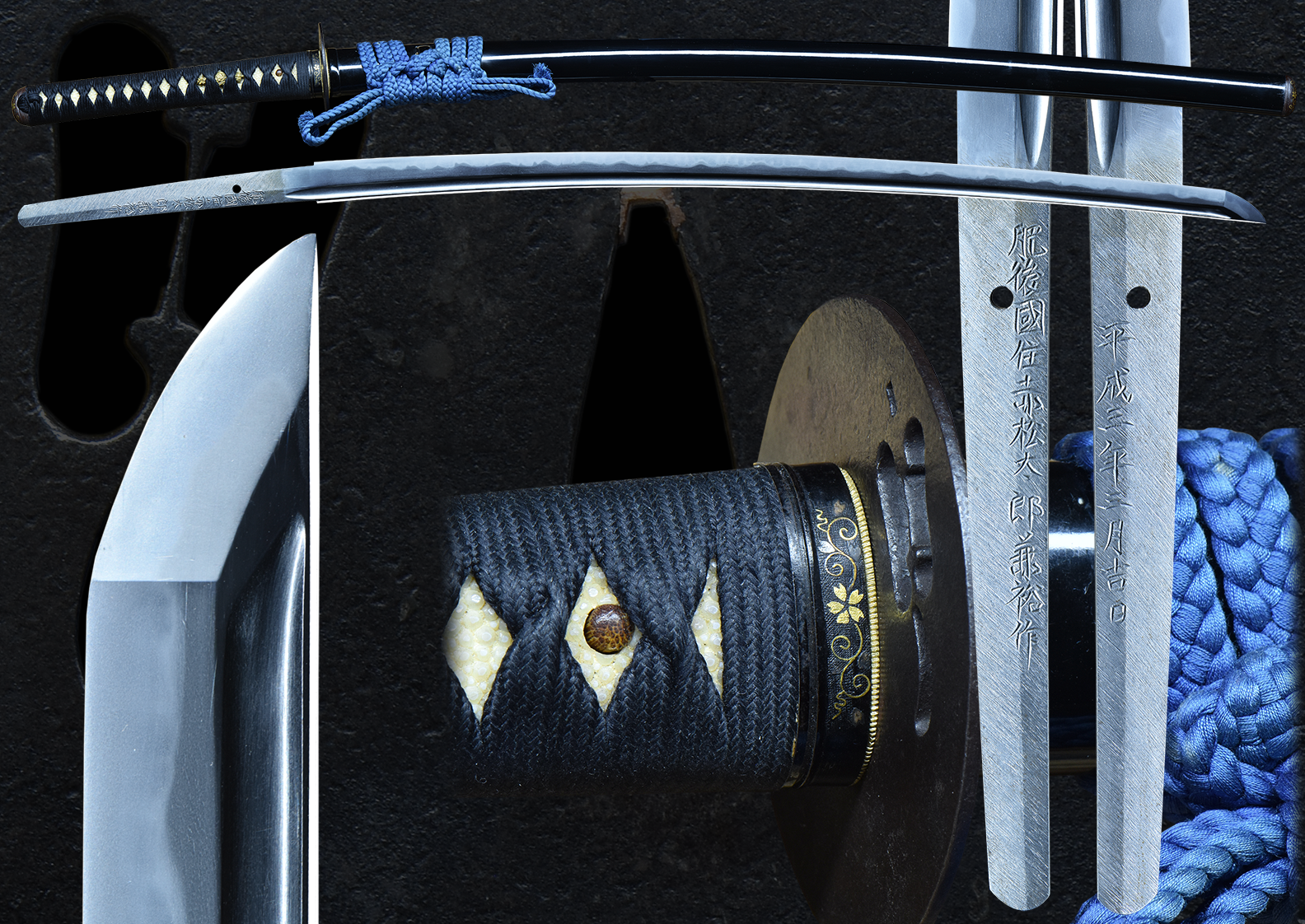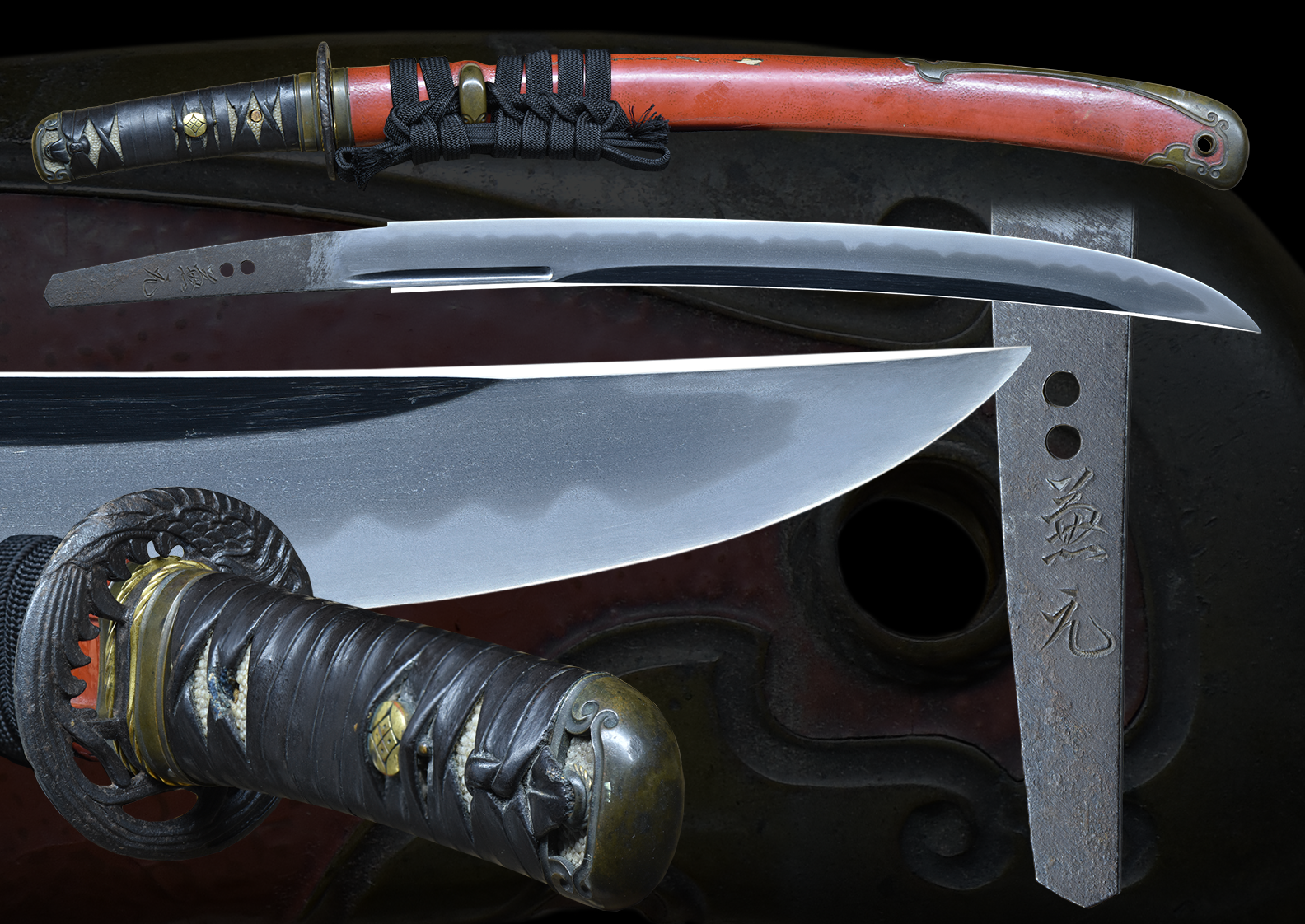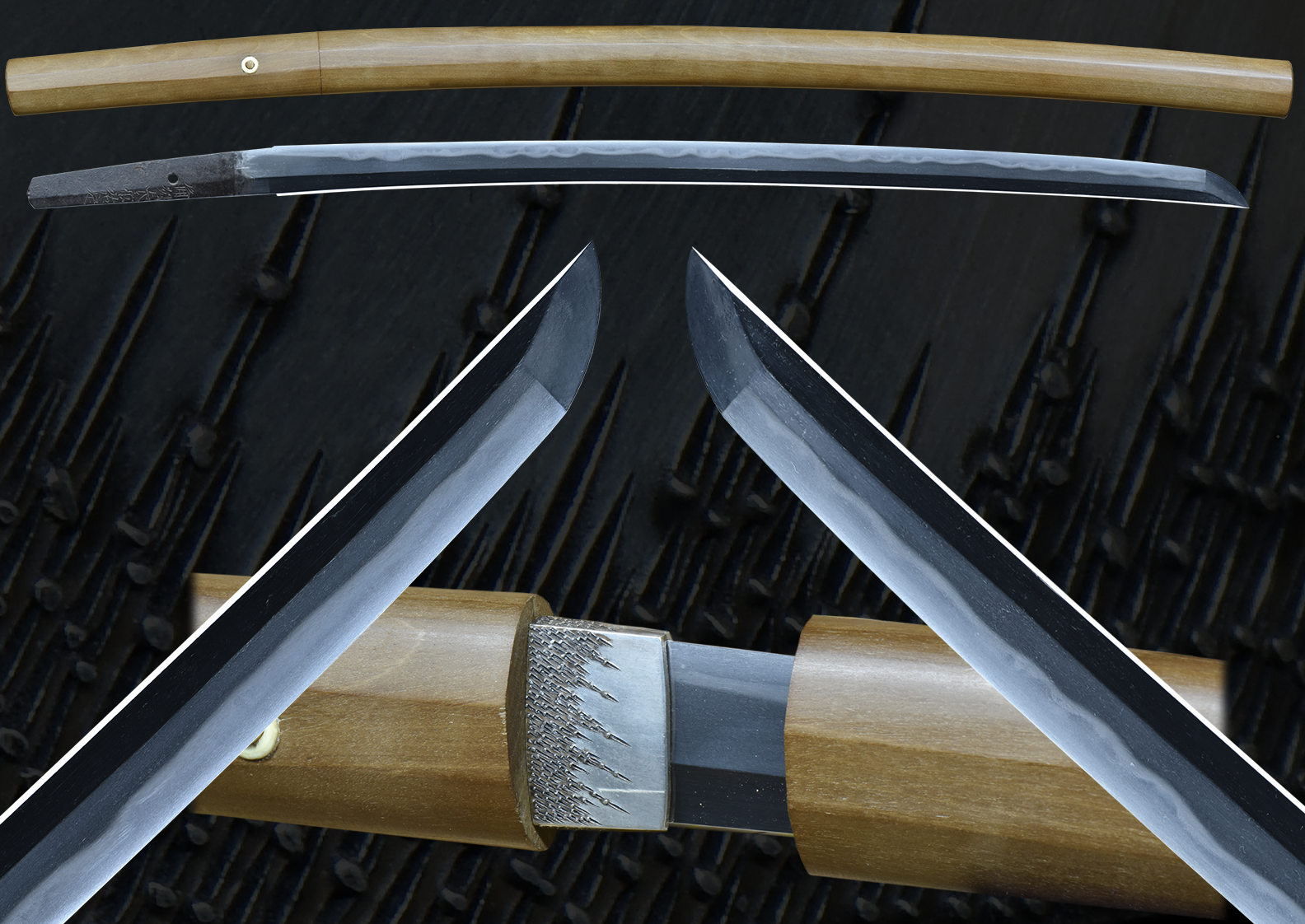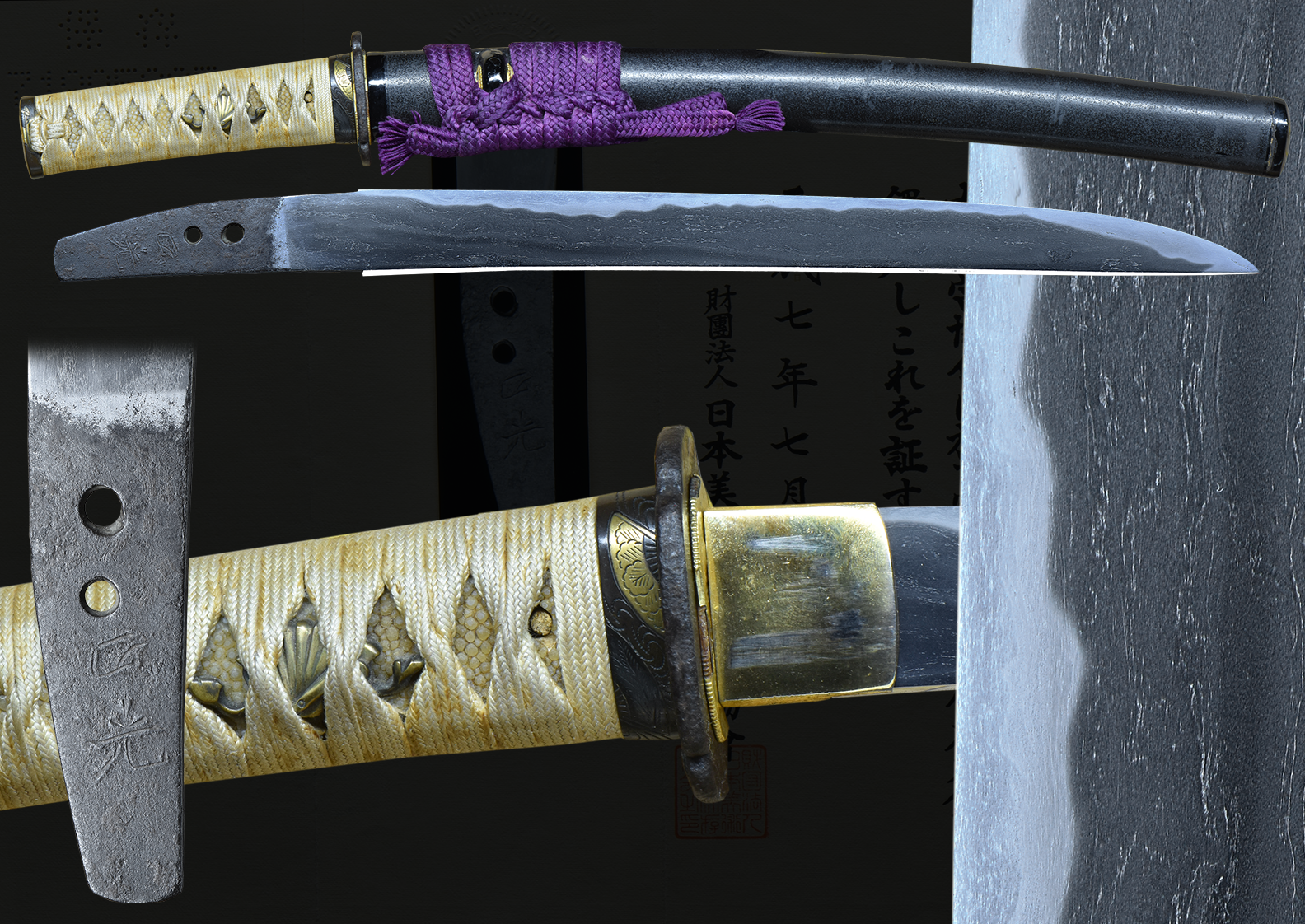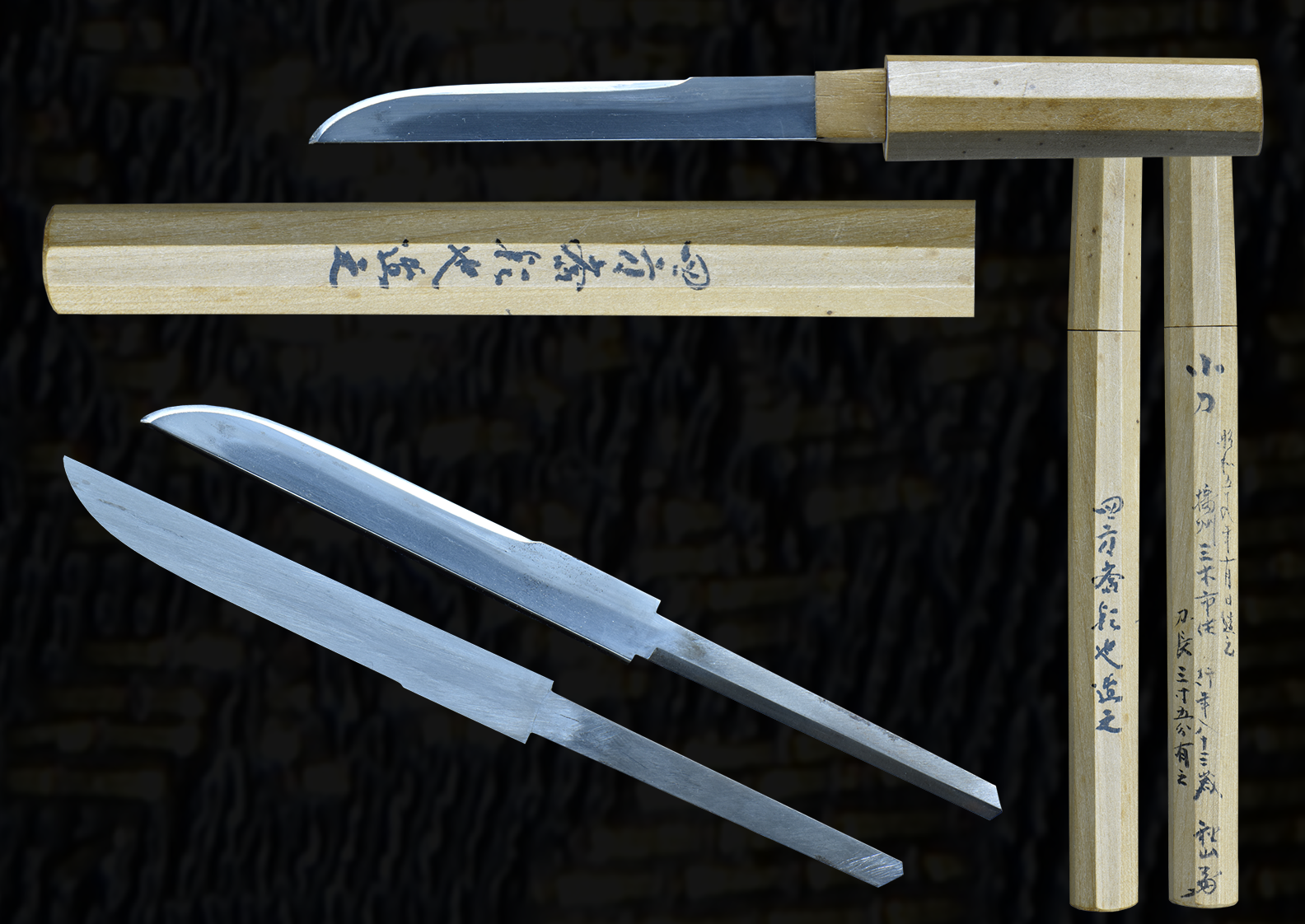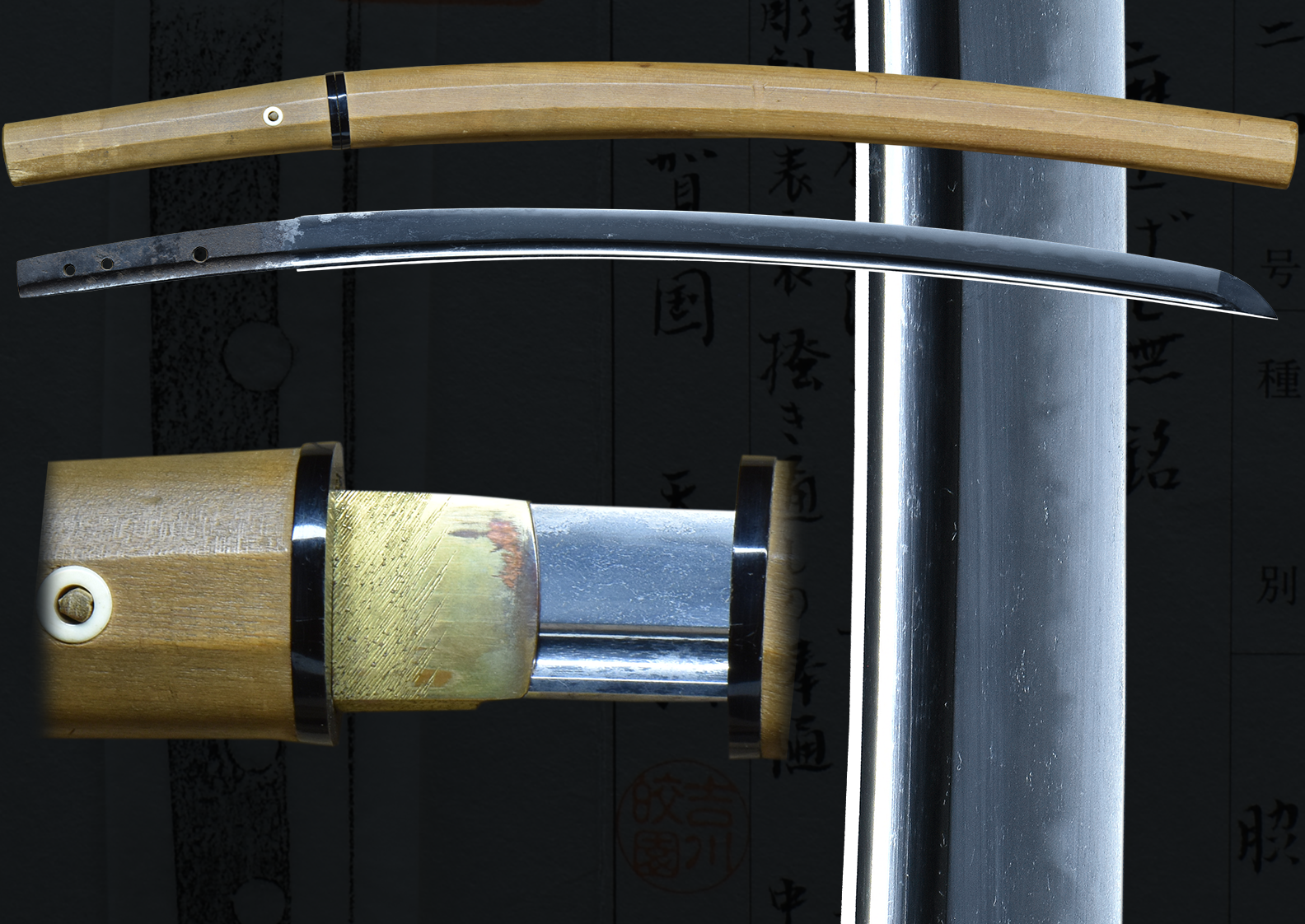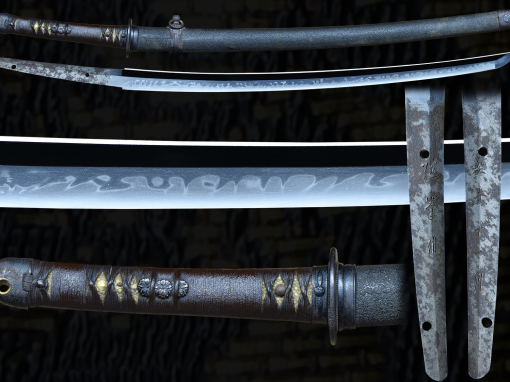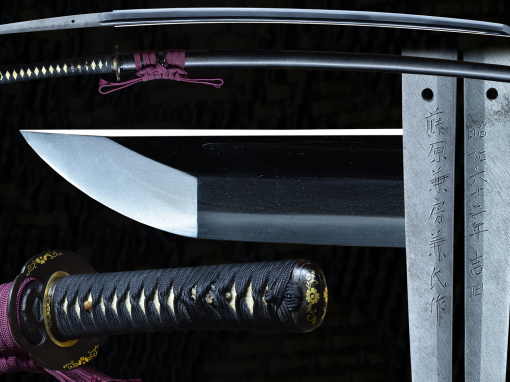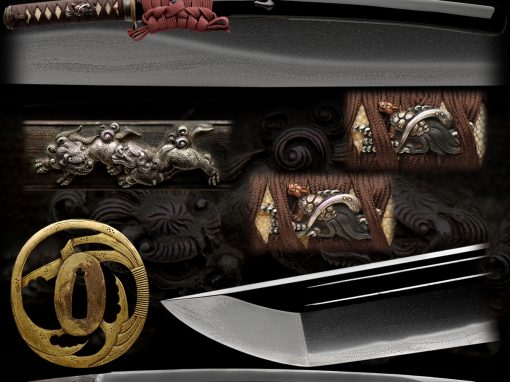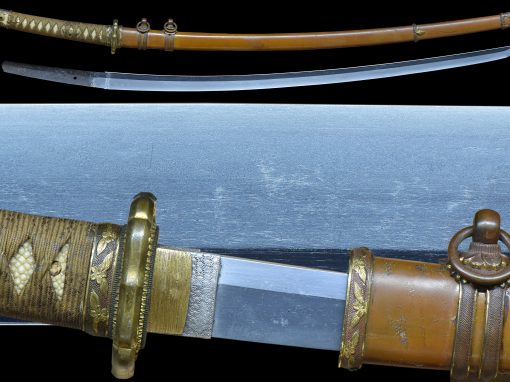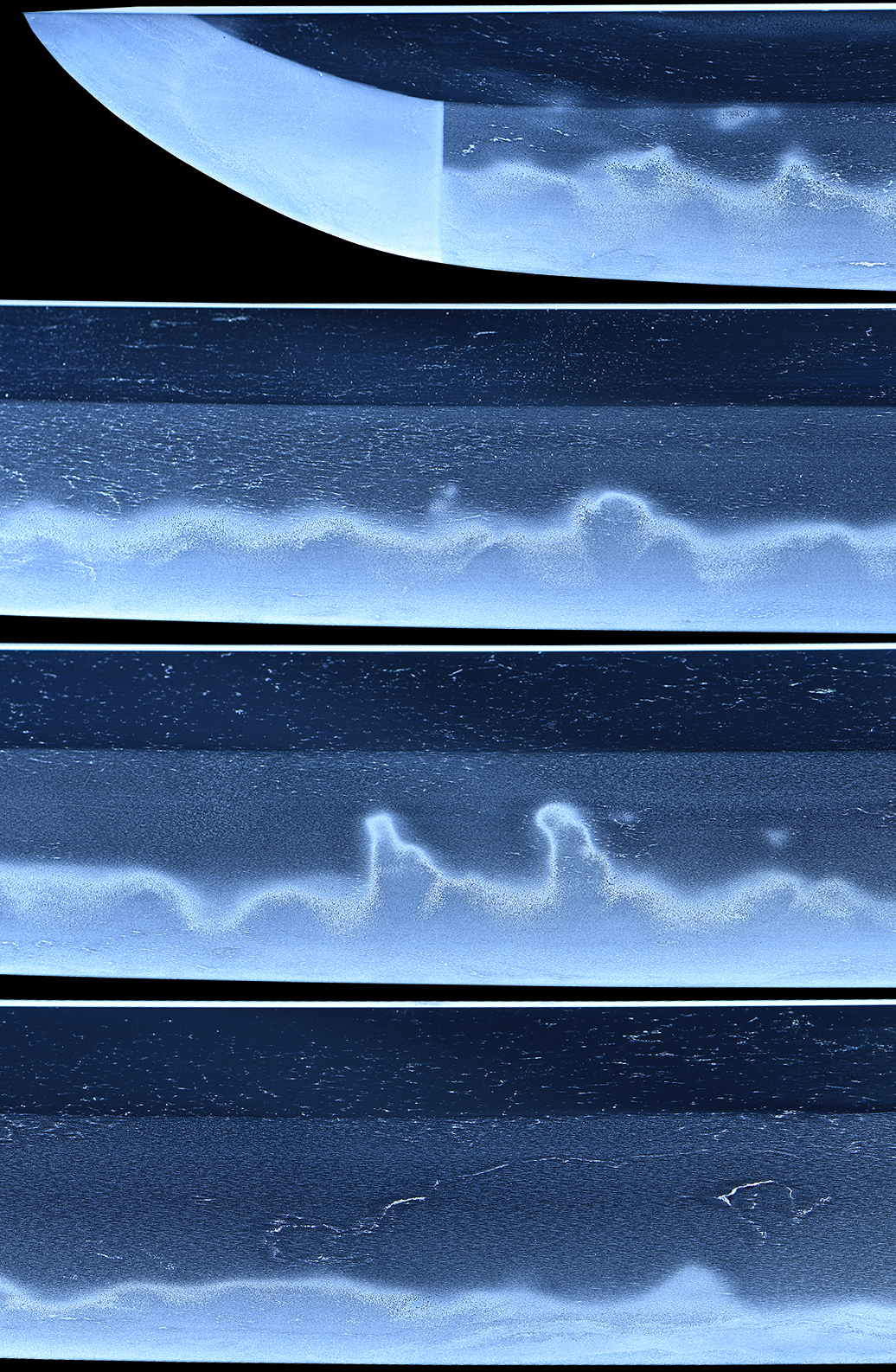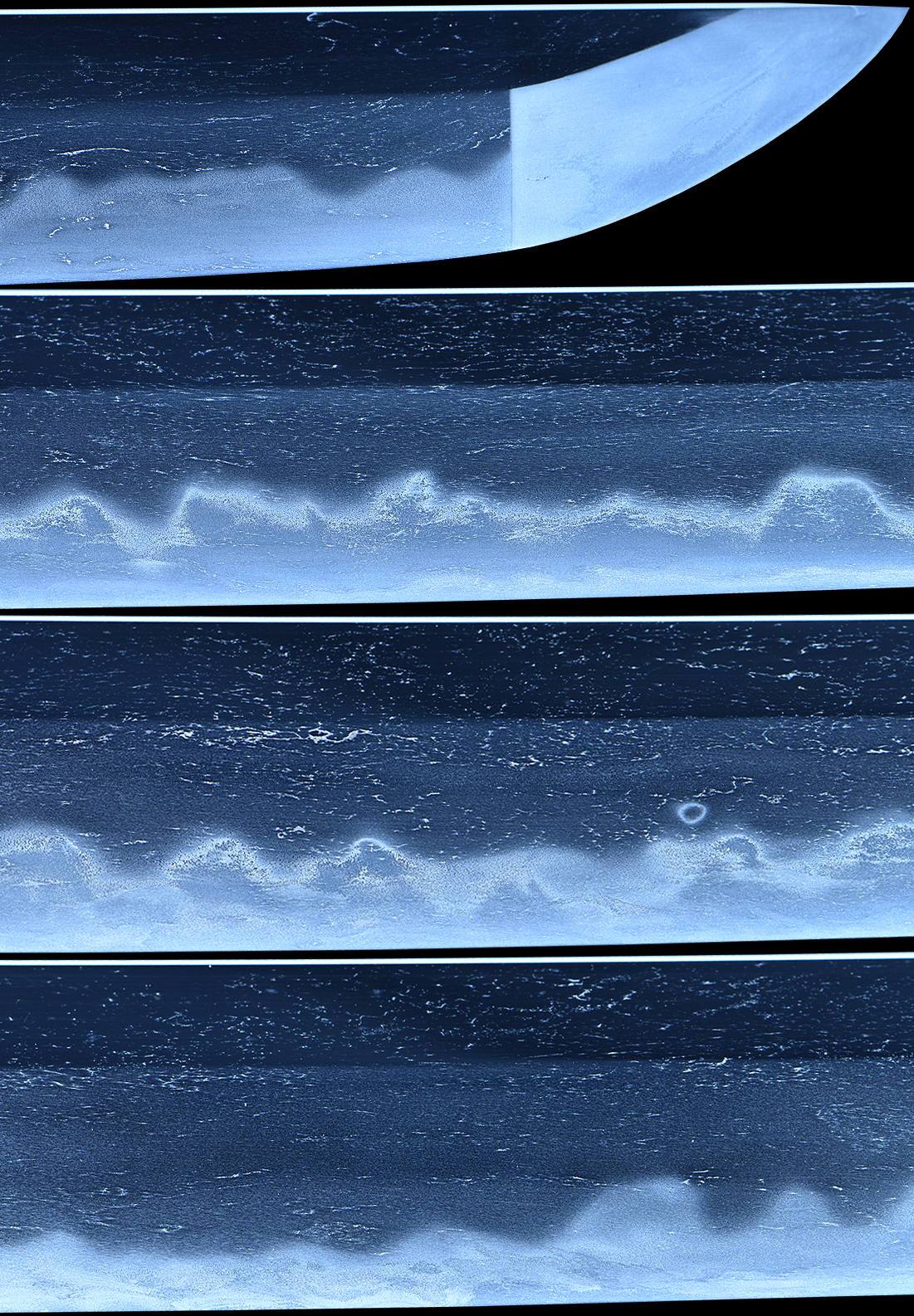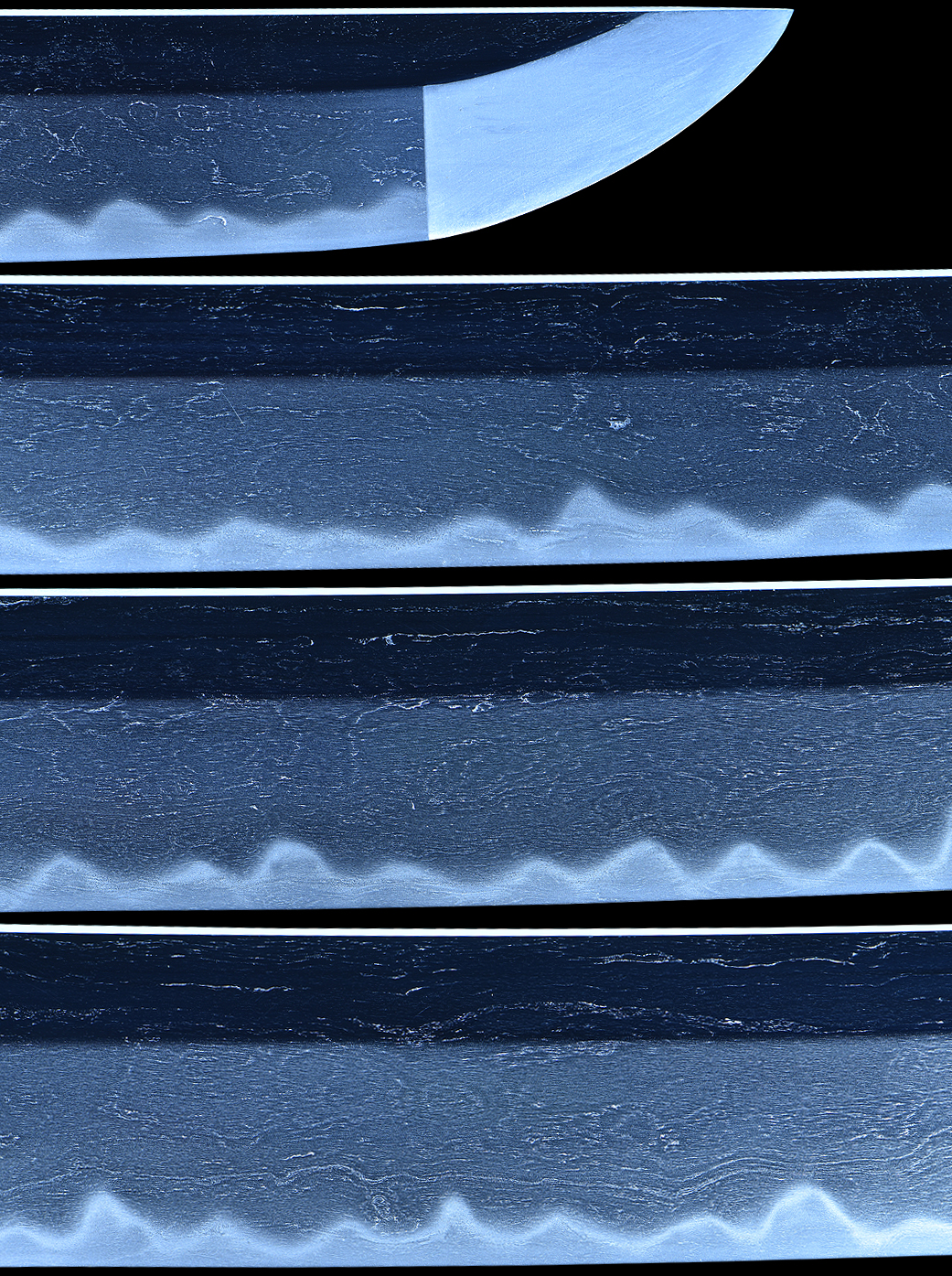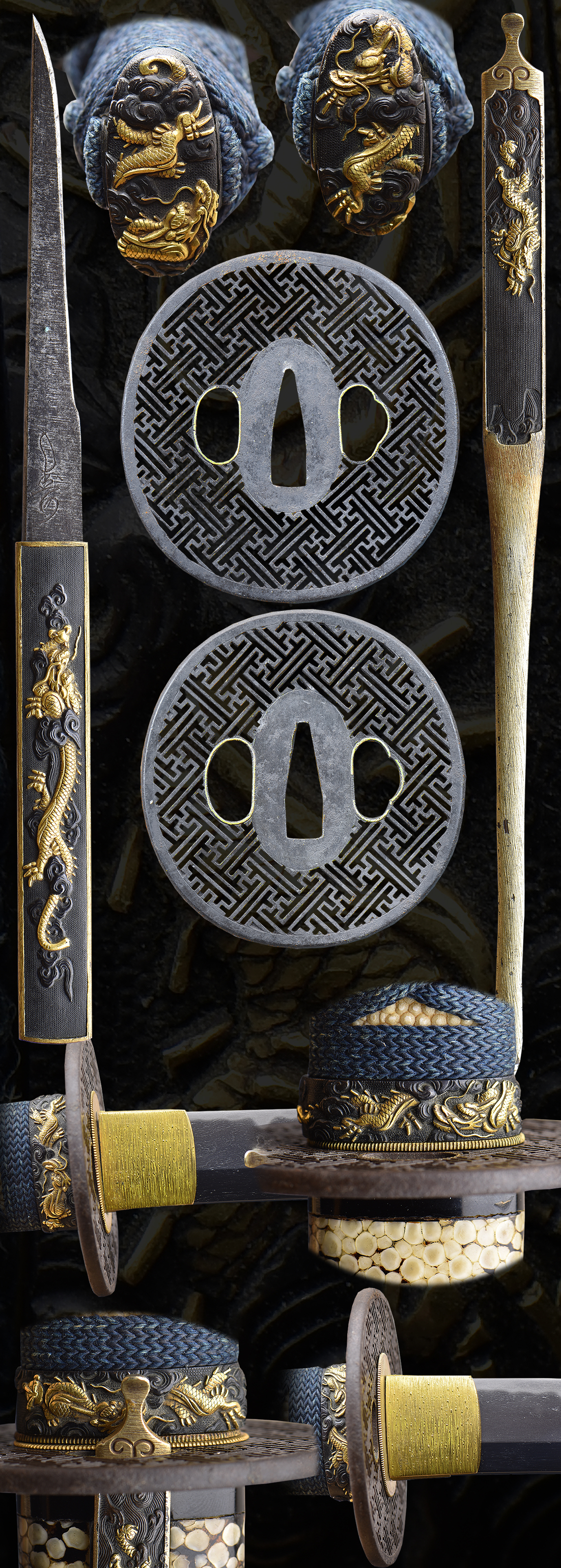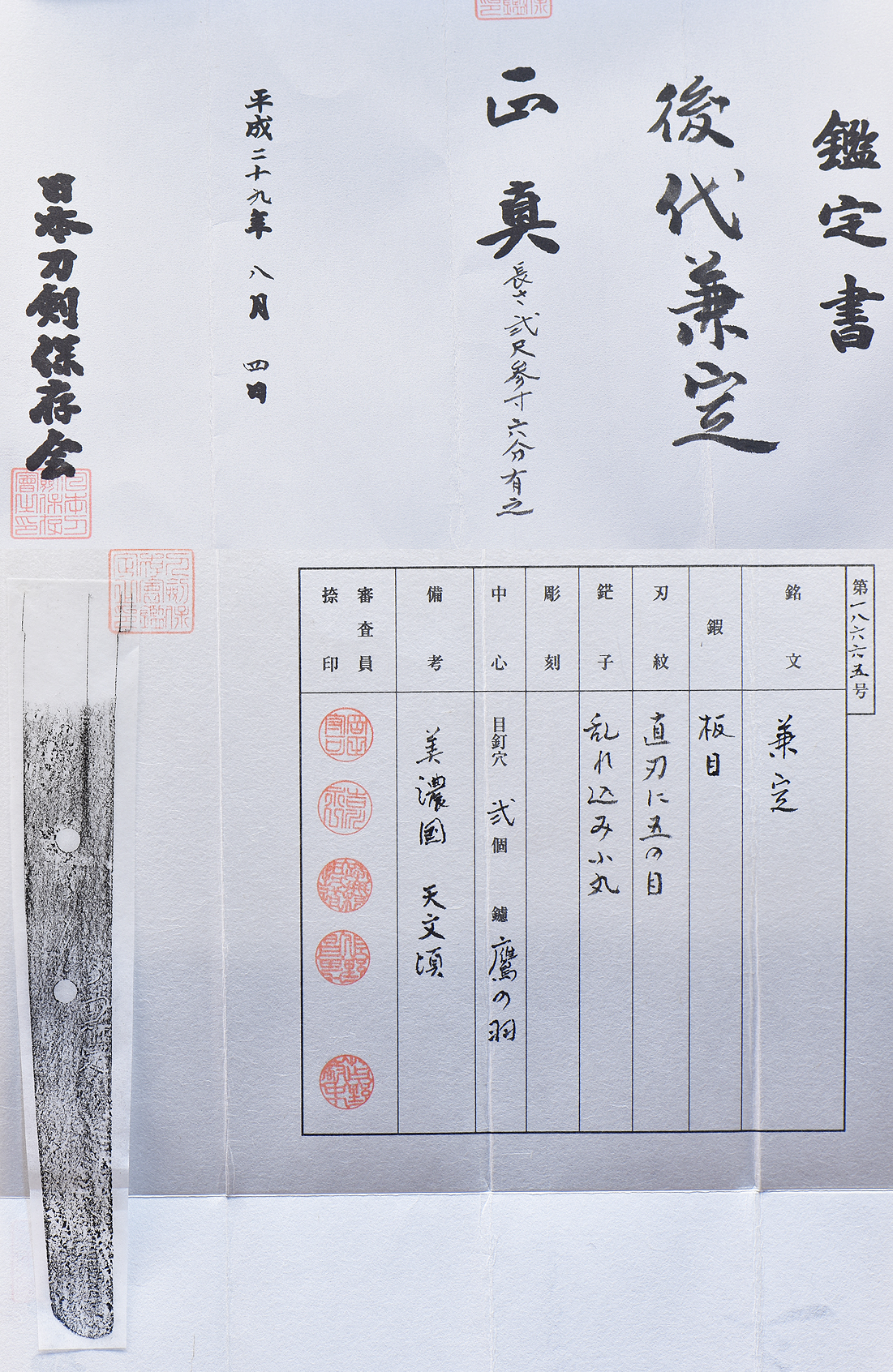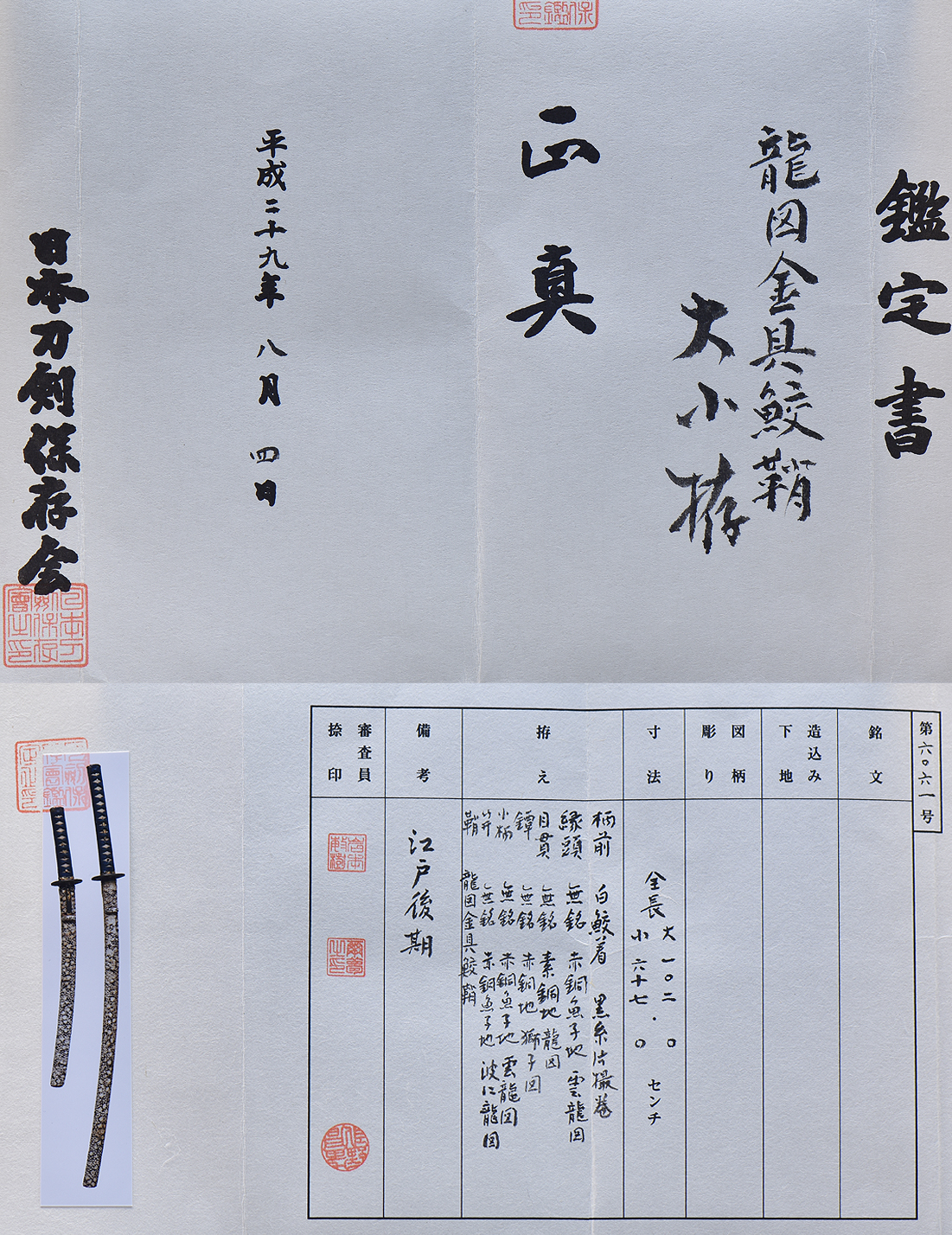Item description:
These swords are mounted in an elegant daisho Koshirae. The saya are elaborately finished in a uniques style of Samegawa. The Same/ray skin is attached to the wooden core and ground down flat and polished after lacquer is applied. This finish is not usually found in this condition. An interesting note: The kurikata of both saya are finished in same(rayskin) which is a rarity. The Motif is of Dragons throughout finished in gold waves and clouds as a backdrop. All the fitting are original and matching. This is a true original Daisho. The koshirae has an ito of blue that is also very old and the sageo are black in color. The Kodzuka blade and ko-gatana are in a dragon motif also with a shakudo/nanako finish. The ko-gatana blade is signed. The menuki are also well made in a dragon motif that compleat the koshirai. The tsubas are of a Buddhist symbol repeated throughout finished in iron. These tsuba are spectacular and the amount of work that went into them is incredible. Both swords have matching gold washed habaki and seppa. Please note that for koshirai or mounts to receive papers they must be original and not put together. This is a real daisho set.
The katana is signed Kanesada . A beautiful blade in pristine polish and loaded with activity from the Shinto period. Within the gunome-midare hamon there is hotsure, sunagashi and kinsugi. The hada is a dense and beautiful itame and mokume mix with some masame and loaded with ji-nie. It has the appearance of the evening sky!
The wakazashi was attributed to kaneharu of the shinto period. A mumei piece this sword has a hamon with O-gunome-midare throughout. The hada is an itame and mokume with ji-nie. This sword reminds one of the work of the Kanemoto line.
Both swords date back to the 1500’s and are koto blades.
Information on daisho history:
The wearing of daishō was limited to the samurai class, and became a symbol or badge of their rank. Daishō may have became popular around the end of the Muromachi period (1336 to 1573)as several early examples date from the late sixteenth century.An edict in 1629 defining the duties of a samurai required the wearing of a daishō when on official duty. During the Meiji period an edict was passed in 1871 abolishing the requirement of the wearing of daishō by samurai, and in 1876 the wearing of swords in public by most of Japan’s population was banned; this ended the use of the daishō as the symbol of the samurai, and the samurai class was abolished soon after the sword ban.
DAI / KATANA
- Mei: Kanesada
- Date: Tenbun (天文, 1532-1555)
- Nagasa: 28-1/8 inches
- Sori: 24.0 mm
- Width at the ha-machi: 27.8 mm
- Width at the yokote: 17.4 mm
- Thickness at the mune-machi: 6.6 mm
- Construction: Shinogi zukuri
- Mune: Iori
- Nakago: Ubu
- Kitae: Itame/mokume
- Hamon: Midare Gunome
- Boshi: Maru
- Condition: Good polish
SHO / WAKAZASHI
- Mei: Mume attributed to kaneharu
- Date: Tenshō (天正, 1573-1592)
- Nagasa: 17-5/8 inches
- Sori: 12.0 mm
- Width at the ha-machi: 26.0 mm
- Width at the yokote: 19.7 mm
- Thickness at the mune-machi: 6.0 mm
- Construction: Shinogi zukuri
- Mune: Iori
- Nakago: Ubu
- Kitae: Itame/mokume
- Hamon: Midare Gunome
- Boshi: Maru
- Condition: Good polish
Click to Enlarge Image
KATANA DETAILS
Click to Enlarge Image
WAKAZASHI DETAILS
Click to Enlarge Image
Yamanaka’s Nihonto Newsletter on Mino Tradition:
In Vol II, two issues were dedicated to discussing the specific characteristics of the key schools and smiths. The key smiths and schools are as follows: Kaneuji and his school, Naoe Shizu (Kaneuji’s followers), Kaneshige (worked in Soshu and Mino traditions), Zenjo School (founded by Kaneyoshi who came from Yamato province) , Kanemoto School, Kanesada School (famous 2nd generation “No-sada”), Akasaka Senjuin (Yamato province, Senjuin School, founder is Kuninaga who moved to Mino province, Hachiya School (founded by Kanesada, different kanji than other “No-sada” group.
Kaneuji:
Hada: Steel grain will show up clearly, much uruoi, ko-mokume with o-hada mixed together, shinogi-ji will have masame, some muneyaki
Hamon: narrow, worked in nie, small designs of gunome-midare w/nie kuzure, rough nie, inazuma, sunagashi in small places, tagariba mixed in places, midare will be small,
Boshi: shallow in midare-komi ending in yakizume or slight kaeri, kaen is seen on some works.
Naoe Shizu:
– resembles 1st and 2nd Kaneuji work, with of hamon becomes wider
Kaneshige:
Hada: small pattern mokume with masame mixed in, masame hada seen in the shinogi-ji
Hamon: narrow and in nie with mura nie, gunome-midare, nie kuzure but lacking nie. Uniform gunome somewhere along the hamon, sunagashi of small pattern seen as well as inazume and kunsuji, some muneyaki
Boshi: gunome in midare-komi which becomes togari at the tip, some yakizume or ko-maru
Zenjo School:
Hada: Same as others, but appears white, very uniform masame in the ji
Hamon: narrow yakiba with nie, but nie is lacking, some suguha hotsure, yakiba becomes wider below the yokote, uniform gunome mixed in somewhere
Boshi: Ko-maru with little kaeri, some boshi are in Ichimonji style (whatever that is).
Kanemoto:
Hada: same as others but with lack of fused steel so hada has ware (openings)
Hamon: narrow yakiba done in nioi some nie in places, ko-midare with ko-gunome or ko-gunome tagari, sambonsuji
Boshi: midare-komi with deep kaeri
Kanesada (No-sada):
Hada: very fine grain mokume with masame, grain will stand out, shinogi-ji will have masame
Hamon: narrow in nioi, some nie, hoso-suguha or shu-suguha, edge of hamon will be very distinct, somewhere along the hamon there will be ko-midare about the size of a pea
Boshi: o-maru with kaeri yoru, some yakizume boshi
Akasaka Senjuin:
Hada: mokume with masame mixed in, individual grains will stand out, very hard looking steel, some blades made in Bizen style have weak steel
Hamon: made in nioi, o-midare, notare midare, hiro suguha, or o-notare with yaki kuzure
Boshi: notare, midare-komi, ko-maru.
Hachiya School (the other Kanesada):
Hada: same as Akasaka senjuin
Hamon: made in nioi with mura nie, o-midare, gunome-choji, notare-midare, yahazu midare, o-notare on on rare occasions hiro suguha and chu suguha, hamon is very distinct, with togari somewhere along the hamon, some koshi-ba, mune-yaki at time.
Boshi: midare-komi or ko-maru, kaeri very deep and stops abruptly
Mino-to:
General: Nice overall work.
(shipping and insurance included)
Email us if your interested in this item and remember to include the order number for this item: fss-633.
Click to Enlarge Image
Kantei-sho (鑑定書) ‒ Appraisal
Kōdai Kanesada (後代兼定) ‒ Later generation Kanesada
shōshin (正真) ‒ Authentic
nagasa 2 shaku 3 sun 6 bu kore ari (⻑さ弐尺参寸六分有之) ‒ Blade length 71.5 cm
Heisei 29 nen 8 gatsu 4 nichi (平成二十九年八月四日) ‒ August 8, 2017
Nihon Tōken Hozon Kai (日本刀剣保存会) ‒ NTHK
No 18665
meibun (銘文) ‒ Signature: Kanesada (兼定)
kitae (鍛) ‒ Forging: itame
hamon (刃紋) ‒ Hardening: suguha with gunome
bōshi (鋩子) ‒ Hardening in tip: midare-komi with a ko-maru-kaeri
chōkoku (彫刻) ‒ Engravings:
nakago (中心) ‒ Tang: mekugi-ana (目釘穴) 2, yasurime (鑢): takanoha
bikō (備考) ‒ Remarks: Mino province, around Tenbun (天文, 1532-1555)
shinsaʼin natsuʼin (審査員捺印) ‒ Seals of Judges: 5 seals
Kantei-sho (鑑定書) ‒ Appraisal
Den Seki Kaneharu (伝関兼春) ‒ Attributed to Seki Kaneharu
shōshin (正真) ‒ Authentic
nagasa 1 shaku 4 sun 8 bu kore ari (⻑さ壱尺四寸八分有之) ‒ Blade length 44.8 cm
Heisei 29 nen 8 gatsu 4 nichi (平成二十九年八月四日) ‒ August 8, 2017
Nihon Tōken Hozon Kai (日本刀剣保存会) ‒ NTHK
No 18491
meibun (銘文) ‒ Signature: mumei (unsigned)
kitae (鍛) ‒ Forging: itame
hamon (刃紋) ‒ Hardening: gunome-midare
bōshi (鋩子) ‒ Hardening in tip: sugu with a ko-maru-kaeri
nakago (中心) ‒ Tang: mekugi-ana (目釘穴) 1, yasurime (鑢): kiri
bikō (備考) ‒ Remarks: Mino province, around Tenshō (天正, 1573-1592)
shinsaʼin natsuʼin (審査員捺印) ‒ Seals of Judges: 4 seals
Kantei-sho (鑑定書) ‒ Appraisal
Ryū zu kanagu samezaya daishō-koshirae (龍図金具鮫鞘大小拵) Daishō-koshirae with samezaya and fittings with dragon motif
shōshin (正真) ‒ Authentic
Heisei 29 nen 8 gatsu 4 nichi (平成二十九年八月四日) ‒ August 8, 2017
Nihon Tōken Hozon Kai (日本刀剣保存会) ‒ NTHK
No 6061
meibun (銘文) ‒ Signature:
tsukurikomi (造り込み) ‒ Shape: shitaji (下地) ‒ Foundation:
zugara (図柄) ‒ Motif: hori (彫り) ‒ Carvings:
sunpō (寸法) ‒ Measurements: overall length dai 102.0 cm, shō 67.0 cm
koshirae (拵え) ‒ Mounting:
Hilt covered with white same and wrapped katatemaki style with black braid; fuchigashira unsigned, of shakudō, with nanako ground and cloud dragon motif;
menuki unsigned, of suaka, depicting dragons; tsuba unsigned, of shakudō, depicting shishi lion(s); kozuka unsigned, of shakudō, with nanako ground and cloud dragon motif; kōgai unsigned, of shakudō, with nanako ground and depicting dragon in waves; samezaya with fitting also depicting dragons
bikō (備考) ‒ Remarks: late Edo period
shinsaʼin natsuʼin (審査員捺印) ‒ Seals of Judges: 3 seals
For Sale
